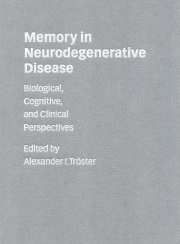Book contents
- Frontmatter
- Contents
- List of contributors
- Preface
- PART I Biological perspectives
- PART II Cognitive perspectives
- PART III Clinical perspectives
- 14 Biological and psychosocial risk factors for dementia and memory loss
- 15 Cross-cultural issues in the neuropsychological assessment of neurodegenerative disease
- 16 Psychometric issues in the clinical assessment of memory in aging and neurodegenerative disease
- 17 The role of memory assessment in the preclinical detection of dementia
- 18 Clinical differentiation of memory disorders in neurodegenerative disease
- 19 The impact of depression on memory in neurodegenerative disease
- 20 Preserved cognitive skills in neurodegenerative disease
- 21 Drug treatment of cognitive impairment in neurodegenerative disease: rationale, current experience and expectations for the future
- 22 Surgical interventions in neurodegenerative disease: impact on memory and cognition
- 23 Memory dysfunction in neurodegenerative disease: ethical and legal issues
- 24 Memory in neurodegenerative disease: clinical perspectives
- Index
18 - Clinical differentiation of memory disorders in neurodegenerative disease
from PART III - Clinical perspectives
Published online by Cambridge University Press: 23 November 2009
- Frontmatter
- Contents
- List of contributors
- Preface
- PART I Biological perspectives
- PART II Cognitive perspectives
- PART III Clinical perspectives
- 14 Biological and psychosocial risk factors for dementia and memory loss
- 15 Cross-cultural issues in the neuropsychological assessment of neurodegenerative disease
- 16 Psychometric issues in the clinical assessment of memory in aging and neurodegenerative disease
- 17 The role of memory assessment in the preclinical detection of dementia
- 18 Clinical differentiation of memory disorders in neurodegenerative disease
- 19 The impact of depression on memory in neurodegenerative disease
- 20 Preserved cognitive skills in neurodegenerative disease
- 21 Drug treatment of cognitive impairment in neurodegenerative disease: rationale, current experience and expectations for the future
- 22 Surgical interventions in neurodegenerative disease: impact on memory and cognition
- 23 Memory dysfunction in neurodegenerative disease: ethical and legal issues
- 24 Memory in neurodegenerative disease: clinical perspectives
- Index
Summary
INTRODUCTION
Cognitive impairment in late life is a growing public health care problem. By the year 2050, conservative estimates indicate as many as 7 to 14 million individuals in the USA (US Census Figures) will be affected by some form of dementia requiring specialized care or institutionalization (Khachaturian 1994). Alzheimer's disease (AD) is by far the most prevalent of the disorders accounting for at least 60% of the progressive dementias. Vascular dementias are believed to account for 20% and a variety of other dementias account for the remaining 20%. Many of these ‘other’ dementias are treatable and some, if treated, are reversible (Breitner and Welsh 1995).
A challenge facing today's clinician is reliably detecting dementia in scenarios where the distinctions between early dementia and normal aging are quite difficult. Accurate diagnoses at this stage are important in allaying anxieties when dementia is not suspected. In the cases of dementia, diagnostic certainty as to the type of dementia can have consequences particularly if the disorder is treatable. In the future, should effective treatment strategies become available for AD and some of the other irreversible forms of dementia, early clinical intervention will be important in an effort to prevent the expression of fulminant symptoms.
At present there is no diagnostic test or biological marker for AD which will permit reliable prediction of who is likely to develop the disease (Roses 1995). Consequently, the diagnosis of this late onset dementia as well as some of the other common neurodegenerative conditions continues to rely on sound clinical methods. It is in this area that neuropsychology has made a significant contribution.
- Type
- Chapter
- Information
- Memory in Neurodegenerative DiseaseBiological, Cognitive, and Clinical Perspectives, pp. 290 - 313Publisher: Cambridge University PressPrint publication year: 1998
- 2
- Cited by



